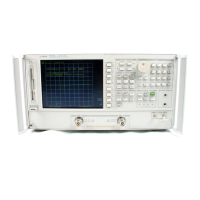n OUTPMSTA insures that the statistics have been calculated for the
current trace before transmitting data. If the statistics are not
activated, it will activate the statistics long enough to update the
current values before deactivating the statistics.
n OUTPMWID insures that a bandwidth search has been executed for
the current trace before transmitting data. If the bandwidth-search
function is not activated, it will activate the bandwidth-search
function long enough to update the current values before switching
OFF the bandwidth-search functions.
Fast Data Transfer Commands
The HP 87533 has four distinct fast data transfer commands. These
commands circumvent the
internal
“byte handler” routine and output
trace dumps as block data. In other words, the analyzer outputs the
entire array without allowing any process swapping to occur.
FORM4,
ASCII data transfer times are not affected by these routines. However,
there are speed improvements with binary data formats. The following
is a description of the four fast data transfer commands:
n OUTPDATF outputs the error corrected data from the active channel
in the current output format. This data may be input to the analyzer
using the INPUDATA command.
n OUTPFORF outputs the formatted display trace array from the active
channel in the current output format. Only the first number in each
of the OUTPFORM data pairs is actually transferred for the display
formats L
0
G
M
H
G
,
F’
H A
!2
E , group DEL
H
‘Y
, L I t-l
14
A
I>
,
S
14
F?
, REAL
and I
II
H
Binary. Because the data array does not contain the second
value for these display formats, the INPUFORM command may not be
used to re-input the data back into the analyzer. The second value
may not be significant in some display formats (see
Table
l-4), thus
reducing the number of bytes transferred.
n OUTPMEMF outputs the memory trace from the active channel. The
data is in real/imaginary pairs, and, as such, may be input back into
the memory trace using INPUDATA or INPUFORM followed by the
DATI command.
n OUTPRAF<I> outputs the raw measurement data trace. The data
may be input back into the memory trace using the INPURAW<I>
command.
HP-IB
Programrm
‘ng and Command Reference Guide
l-39

